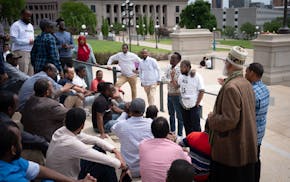With a fight brewing over how to fix Minnesota's deteriorated roads and bridges, leading Republicans and conservative activists are advocating relying on borrowed money instead of raising taxes to pay for more improvements.
The strategy is being advanced as Gov. Tim Pawlenty today reveals his recommendations for the 2008 bonding bill to finance construction projects around the state.
House Minority Leader Marty Seifert, R-Marshall, is calling for using perhaps half of nearly $1 billion in state bond funds expected to be available this year to help pay for local road and bridge projects.
Seifert said he hopes Pawlenty will devote more money for local roads and bridges in his bonding proposal. If Pawlenty dedicated at least one-third of the bonding bill to such spending, "we would be ecstatic," Seifert said.
But a leading DFLer said there wouldn't be enough money in the bonding package to eliminate a shortfall of more than $1.5 billion annually for state and local roads, highways and bridges.
"Even if you dedicate part of this year's bonding bill to that purpose, it still comes nowhere close to dealing with the huge infrastructure problem that is out there," said Sen. Richard Cohen, DFL-St. Paul, a member of the Senate Capital Investment Committee.
Seifert's approach is shared by Phil Krinkie, president of the Taxpayers League of Minnesota and a former legislator, who said Friday that the state spends too much of its bonding authority on "government boondoggles" and should shift the emphasis to transportation.
He criticized bonding proposals to spend $2 million on a polar bear exhibit in Duluth, $800,000 for a State Fair fish habitat display and millions more on trails.
"If bonding bills were primarily made up of necessary road and bridge projects, there would be little room left for the pork that legislators bring home to their districts to help with their reelection efforts," Krinkie said.
Need for taxes debated
Major bonding bills are passed every two years. The 2006 bill provided a similar amount of money, with 7.5 percent going to local roads and bridges. Another 7.5 percent went directly to other local transportation projects, most of it for the Northstar commuter line.
Seifert said if half of the bonding bill were dedicated every two years to local roads and bridges, "we would have a long-term fix on roads and bridges without raising taxes."
Cohen said even setting aside bond money on a regular basis won't be adequate. He said using substantially more of the state's bonding authority to pay for local roads and bridges would force legislators to cut bonding to finance necessary construction for universities, environmental projects or other improvements.
"What they don't want to own up to is there are times when you have to look at taxes," Cohen said of Republicans. "And we haven't raised the gas tax in over two decades, and the consequences are we have a transportation system that's an absolute mess."
Pawlenty has twice vetoed measures to raise the gas tax. Cohen, other DFLers and some suburban Republican legislators have favored raising the gas tax by 5 cents.
"They just want to raise taxes, they don't want to say no to the polar bears and the hockey arenas and those types of things," Seifert said of the DFL.
Pawlenty spokesman Brian McClung did not respond Friday when asked whether the governor would recommend using a greater share of the bonding bill for local roads and bridges.
Krinkie also argued that the state Constitution could be interpreted to allow using general obligation bonds to finance state highway and bridge projects in addition to local road and bridge projects. The Department of Finance received a legal opinion in 2001 saying the issue was unclear.
Pat Doyle • 651-222-1210
Senior Republican close to Trump criticizes Biden's arms holdup in speech to Israeli parliament

Minnesota legislators headed toward chaotic and partisan finish of 2024 session

House approves minimum pay for Uber and Lyft drivers, Senate vote pending


